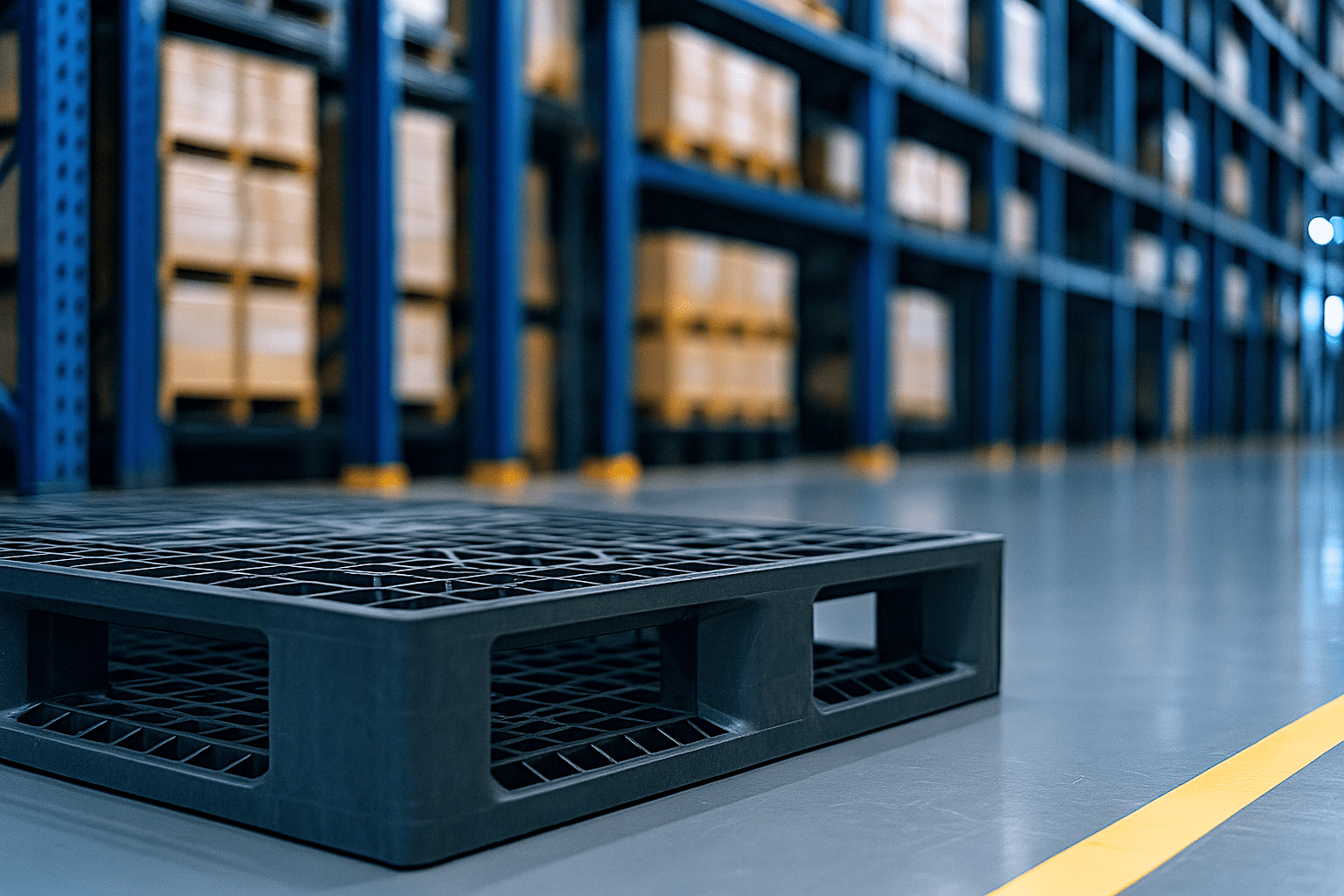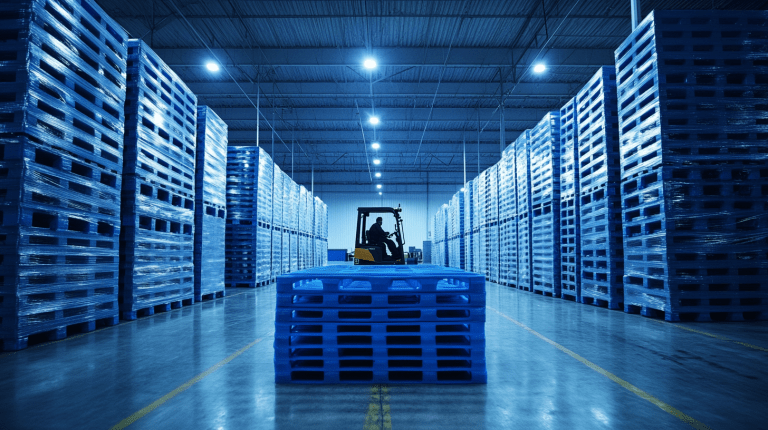Pallets are flat, portable platforms used to store, move, or transport goods.
Often found in warehouses, factories, and vehicles, they play a crucial role in supply chains and enable efficient stacking, organising, and moving of products via tools like forklifts and pallet jacks.
While pallets can be made from a variety of materials — wood, plastic, metal, and paper — wooden pallets still account for a majority of all pallets used globally. The situation, however, is very different in Asia. In countries like Korea, plastic pallet is already accounting for at least 70% of the market. For Malaysia, it constitutes about half of the market. Major pallet users heave already switched to plastic pallets.
However, in recent years, there is a growing trend of companies shifting from traditional wooden pallets to eco-friendly plastic pallets, for a variety of reasons.
So, what are plastic pallets?
Plastic pallets are sturdy platforms made from materials like high-density polyethylene (HDPE) or polypropylene copolymer (PPC) via processes like injection moulding and blow moulding.
Their standardised pallet dimensions, often matching standard pallet size, ensure compatibility with global logistics systems. Furthermore, their versatility shines through in the growing demand for heavy-duty plastic pallets, lightweight plastic pallets, and hygienic plastic pallets, catering to diverse industry needs.
With industries prioritising automation and sustainability, businesses are increasingly adopting plastic pallets due to their efficiency, long lifespan, and environmental benefits.
In Malaysia, one of the leading plastic container manufacturers is See Hau Global Sdn Bhd, known for its environmentally friendly plastic pallets, IntracoPalletTM.
Here is a closer look at the different types of plastic pallets:
- Stackable Pallets: Ideal for space-saving storage
- Rackable Pallets: Designed for use in conventional rack storage as well as automated warehouse systems and automatic storage retrieval systems (ASRS)
- Export Pallets: Lightweight and cost-efficient, perfect for single-use international shipping
- Heavy-Duty Pallets: Built to handle significant loads in demanding industries
- Hygienic Plastic Pallets: Critical for sectors like food, beverage and pharmaceutical
But why are plastic pallets revolutionary?
While plastic pallets serve the same core functions as wooden pallets, they offer distinct advantages that are driving more companies to adopt them.
1. Plastic pallets are more durable
Heavy-duty plastic pallets are resistant to moisture, pests, and wear, ensuring longer life. They can also withstand heavy loads and repeated use.
2. Plastic pallets are more sustainable
Recyclable plastic pallets help minimise landfill waste while supporting eco-conscious initiatives. For example, IntracoPalletTM is crafted entirely from 100% recyclable plastics, enabling companies to significantly reduce their carbon footprint. In addition, See Hau Global runs a pallet circularity program in which the company buys back used pallets from customers and recycle them into export shipping pallets.
3. Plastic pallets are more cost effective
Though the upfront investment in plastic pallets may be higher in some cases, their low maintenance and longevity lead to long-term savings. Hence the overall cost of ownership for plastic pallets is lower than pallets of other made.
4. Plastic pallets are more hygienic
Hygienic plastic pallets are easy to clean, making them essential for industries requiring strict sanitation. They are also resistant to moisture, bacteria, and other contaminants, making them ideal for F&B, pharmaceutical and industries that require 5S, GMP or HACCP compliance.
5. Plastic pallets function better for automation
Plastic pallets are about 50% lighter than wooden pallets, reducing stress on equipment. Its consistent design and smooth surfaces make transport easier and less wear and tear to conveyors, lifts, and vehicles. Plastic pallets are also strong and reliable, as they won’t split or warp like their wooden counterparts.
In modern logistics, automation warehouses depend on tools like plastic pallets and material handling equipment. Their uniform pallet dimensions and compatibility with automatic storage retrieval systems (ASRS) make them indispensable for efficient operations.
Here’s a comparison between plastic pallets and wooden pallets:
| Plastic pallets | Wooden pallets | |
| Cost | Warehouse pallets are of higher initial cost but more cost-effective long-term due to longevity. Shipping pallets cost are comparable | Lower upfront cost; affordable for short-term use. |
| Maintenance | Minimal maintenance; resistant to moisture, chemicals, and pests. | Requires frequent repairs; prone to splinters, rot, and pest damage. |
| Durability | Highly durable; can withstand heavy loads and harsh environments. | Less durable; susceptible to breaking, weathering, and wear. |
| Environmental impact | Recyclable and reusable; supports sustainability goals and reduces landfill waste. | Biodegradable but often single-use; contributes to deforestation and waste. |
All in all, plastic pallets are more than just an alternative to traditional wooden pallets — they are an innovation driving the evolution of modern logistics.
Businesses that invest in plastic pallets today stand to benefit from cost savings, operational efficiency, and a reduced environmental footprint.
With an increasing global focus on eco-friendly practices, businesses are expected to embrace recyclable plastic pallets to align with sustainability goals and reduce their carbon footprint.
Their durability and reusability make them a key component of a circular economy, minimising waste and promoting resource conservation.
In addition to sustainability, technological innovations are set to propel the adoption of plastic pallets. For example, RFID tracking and embedded sensors are becoming standard features, enabling real-time tracking, inventory management, and improved supply chain visibility. These advancements are particularly beneficial for automation warehouses and automatic storage retrieval systems (ASRS), where the uniformity and precision of plastic pallets enhance efficiency and integration.
Eventhough RFID tags can be attached to wooden pallets, this leads to easy losses as wooden pallets can crack or lose boards during use. Other the other hand, RFID tags are typically secured inside plastic pallets, resulting in much better system security and durability.
Emerging trends such as the development of lightweight yet heavy-duty plastic pallets, customisable designs, and temperature-resistant materials will further expand their applications across diverse industries. The adoption of plastic pallets for export is also likely to grow as they meet international shipping standards, avoid pest-related restrictions, and ensure hygiene compliance.
For tailored solutions and expert guidance on how plastic pallets can revolutionise your logistics, connect with our team today.





